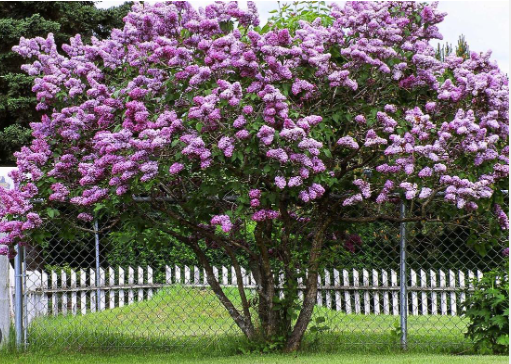Syringa × chinensis, commonly called Chinese lilac or Rouen lilac, is is a hybrid species resulting from a cross between Syringa vulgaris (common lilac native to southern Europe) and Syringa persica (Persian lilac native to Persia now Iran). It was supposedly first noticed growing in Rouen, France in 1777. In spite of its specific and common names, it most probably originated in western Asia.
The Chinese lilac reaches a height of 8-12 feet (less frequently up to 15 feet) and produces some suckers (shoots from the stem or root). Due to its rounded, bushy growth, it may be grown as a shrub or hedge or, by clearing away the suckers, as a small tree. The bark of the Chinese lilac is grayish-brown and develops an attractive, furrowed texture with age. The branches are sturdy and may arch particularly when laden with flowers.
When in full bloom, the shrubs appear beautiful in the landscape. It even attracts butterflies, bees, and other pollinators to the garden.

Botanical Characteristics
- It is a spreading, multi-trunked deciduous shrub with arching branches, typically reaching heights of 8-12 feet (less frequently up to 15 feet).
- The leaves and flowers of Chinese lilac resemble those of Persian lilac, while the erect growth and abundance of flowers are more similar to common lilac.
- The plant produces airy pyramidal inflorescences, around 4-6 inches long, composed of very fragrant rose-purple flowers that bloom in mid-May.
- Following the flowers, brown dehiscent capsules appear, which persist on the shrub into winter.
- The leaves are opposite, simple, and ovate-lanceolate, typically medium to dark green in color. However, foliage may lose its sharpness due to powdery mildew in summer.
- There is no significant color change in the leaves during fall.
- In optimal conditions with proper care, Chinese lilacs can live for 20 to 30 years or even longer. However, some may have shorter lifespans due to factors like disease, pests, adverse weather conditions, or inadequate care.
- The USDA Hardiness Zones for Syringa × chinensis, or Chinese lilac, generally range from Zones 3 to 7.
How to grow and care for Chinese Lilac
| Sunlight | Full sun to partial shade is preferred. |
| Soil | Well-draining, loamy soil with a slightly acidic to neutral pH. |
| Watering | Water regularly, especially during the first growing season to establish roots. |
| Pruning | Prune after flowering to shape and remove dead or damaged branches. |
| Fertilization | Apply a balanced fertilizer in spring before new growth starts. |
| Mulching | Mulch around the base to retain moisture and suppress weeds. |
| Winter Care | Generally hardy, but protect young plants from frost. |
| Pests | Watch for aphids, scale insects, and spider mites. Treat infestations promptly. |
| Diseases | Watch for powdery mildew, leaf spot, and root rot. Ensure good air circulation and drainage. |
| Propagation | You can propagate through seeds. |
Cultivars of Chinese Lilac (Syringa × chinensis)
- ‘Red Rothomagensis’: This variety feature deep red-purple flowers and strong fragrance. It grows as a spreading shrub with arching branches.
- ‘Saugeana’: ‘Saugeana’ features clusters of pale lavender-pink flowers with a delightful fragrance. It has a compact growth habit. It is often used as a specimen plant or in hedges.
- ‘Willowleaf’: As the name suggests, ‘Willowleaf’ has elongated, narrow leaves resembling those of a willow tree. Its flowers are pale pink and very fragrant, blooming in large clusters.
- ‘Charles Joly’: This variety is a cross between Syringa vulgaris and Syringa × chinensis. It produces double magenta-pink flowers that are highly fragrant.
- ‘Miss Canada’: ‘Miss Canada’ feature bright pink flowers that bloom in large clusters.
- ‘Laciniata’: Also known as Cutleaf Lilac, this variety feature deeply cut, fern-like foliage. Its flowers are light purple and are mildly fragrant.
- ‘Maiden’s Blush’: This variety is characterized by pale pink flowers with a sweet fragrance. It has a spreading growth habit.
Common Diseases That Affect Chinese Lilac
Powdery Mildew
Powdery mildew appears as a white, powdery substance on the leaves, stems, and sometimes flowers of the plant. This disease thrives in warm, humid conditions and can weaken the plant over time if left untreated. To prevent powdery mildew, ensure good air circulation around the plant, avoid overhead watering, and prune away any infected foliage.
Leaf Spot
Leaf spot causes dark spots to appear on the leaves, which may eventually turn yellow and drop from the plant. Leaf spot is often favored by moist conditions and can spread rapidly in crowded plantings. To prevent leaf spot, avoid overhead watering, thin out crowded branches to improve air circulation, and remove any infected leaves promptly.
Bacterial Blight
Bacterial blight causes dark, water-soaked lesions on the leaves and stems. In severe cases, it can cause wilting and dieback of branches. Bacterial blight is often spread through water, so avoiding overhead watering and watering the plant at the base can help prevent its spread. Pruning out infected branches and improving air circulation can also help manage this disease.
Verticillium Wilt
Verticillium wilt causes wilting and yellowing of the leaves. It starts on one side of the plant and spreading over time. The disease can survive in the soil for many years. Planting Chinese lilac in well-draining soil, avoiding stress to the plant, and promptly removing and destroying infected plant material can help prevent the spread of this disease.